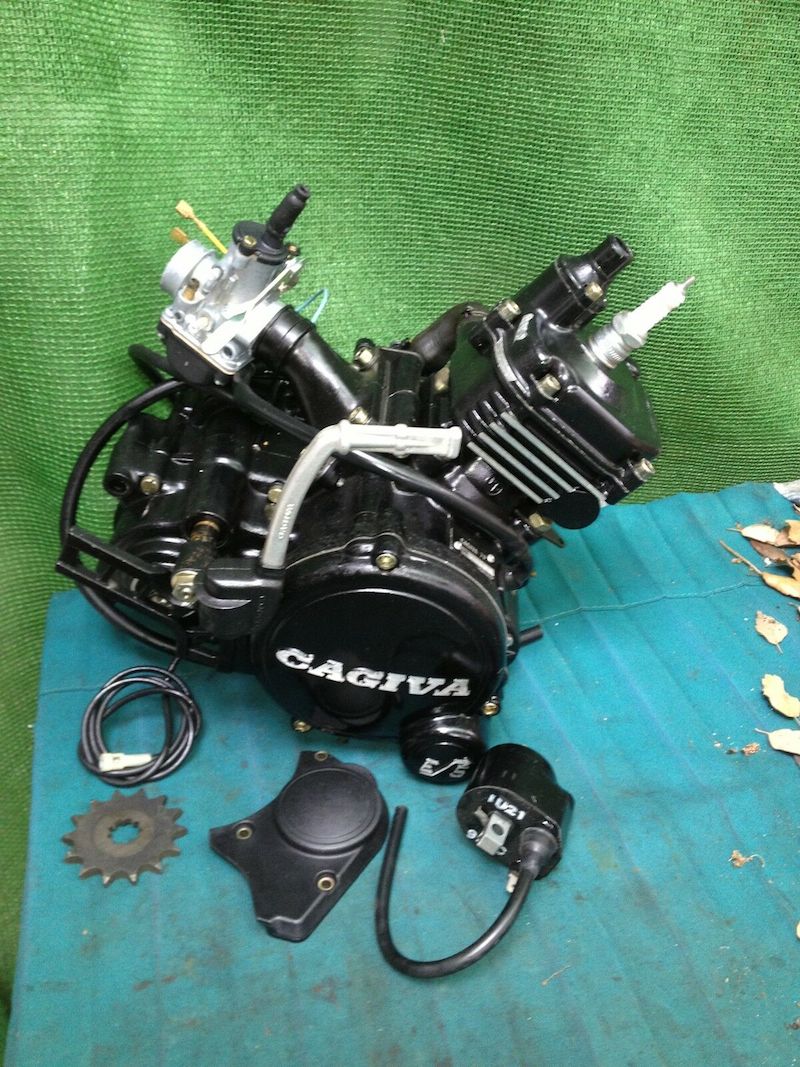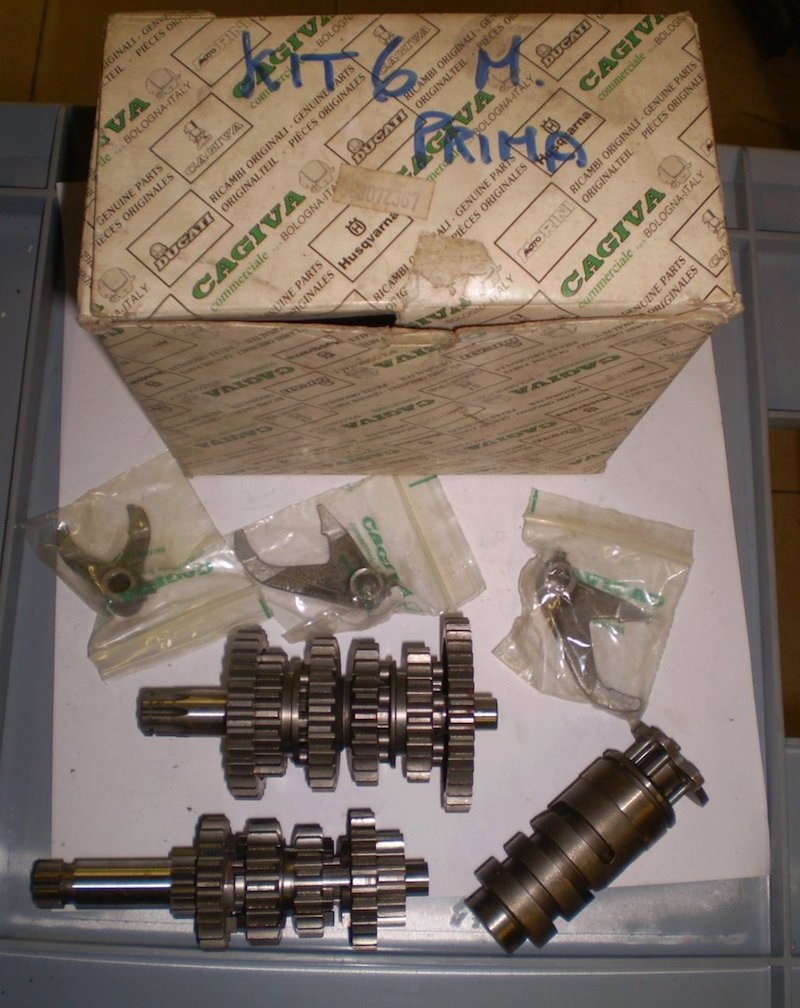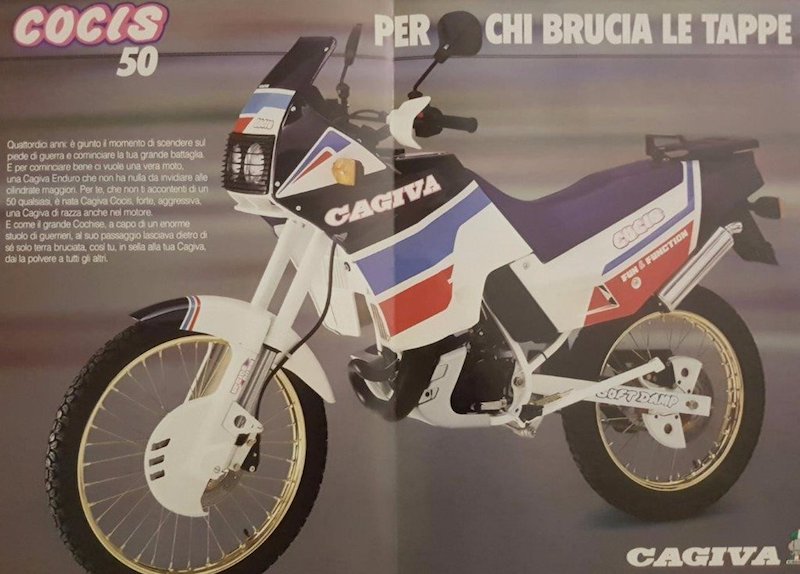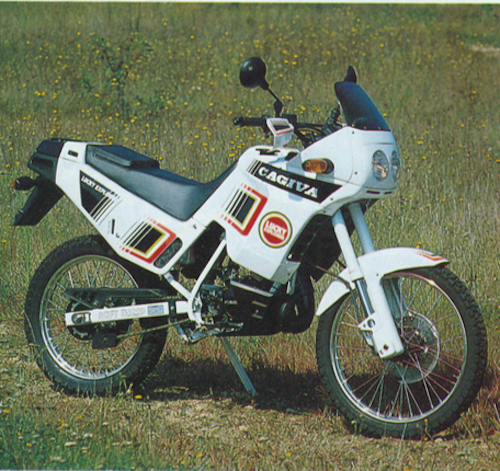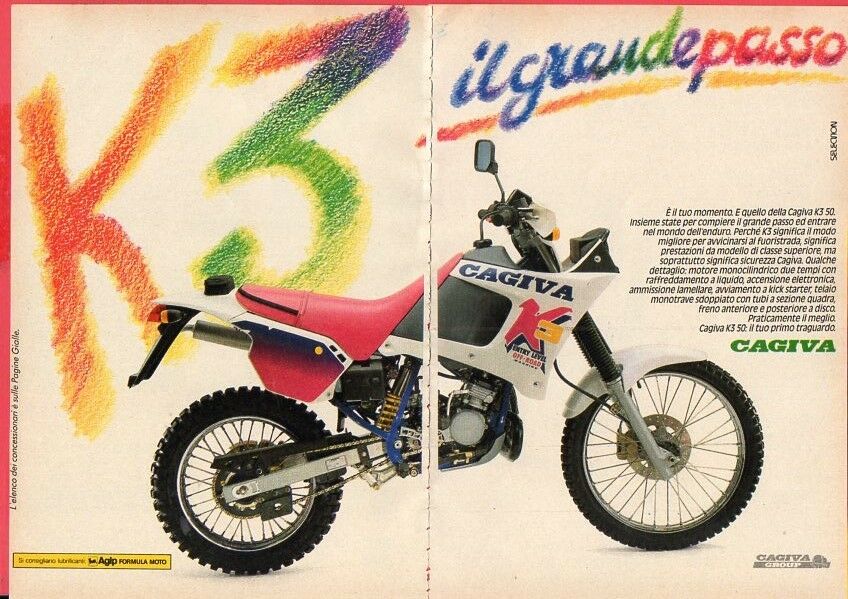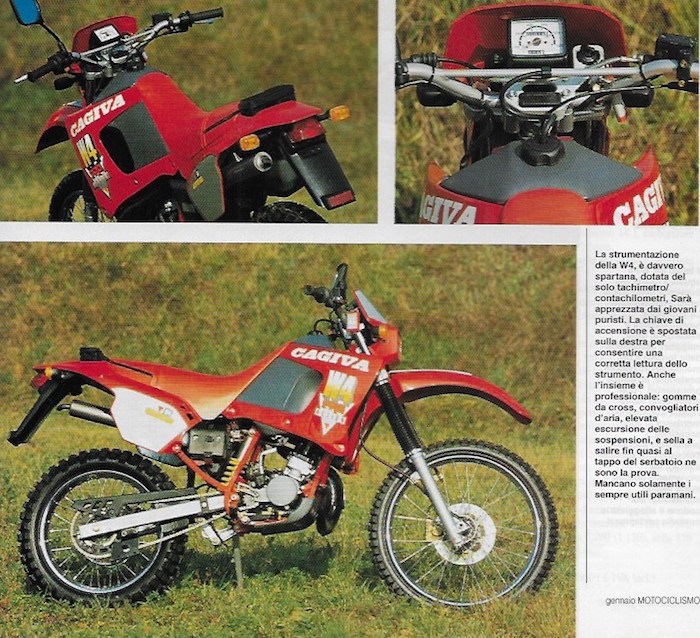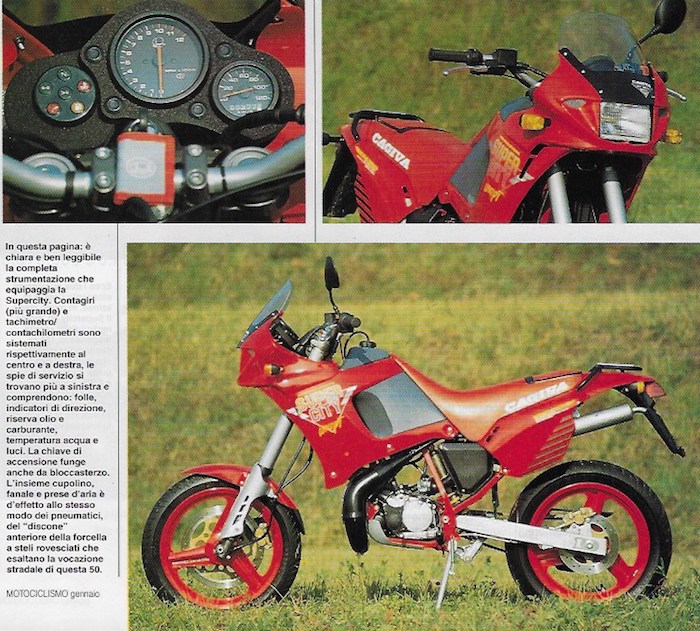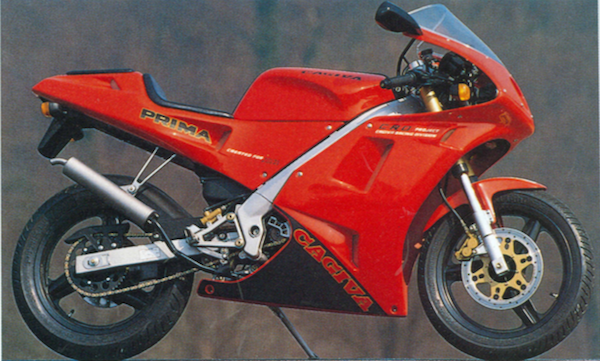Cagiva entra nel settore delle moto 50cc con la Cocis 50 del 1988, una moto direttamente ispirata al 125cc Tamanaco. Come per le ottavo di litro, Cagiva produce il suo motore e lo fa con grande stile, dotandolo – tra le altre caratteristiche – dell’ammissione lamellare nel carter e del contralbero antivibrazioni, due novità assolute per un propulsore di cilindrata così ridotta. Nel 1989 arriverà il Cocis 2a serie ispirato alla enduro N90 e più avanti la W4 e la K3 a loro volta ispirate alle sorelle di 125cc. Tra le versioni stradali, la Prima 50 (poi diventata Mito 50) ed il supermotard Supercity 50 (ispirato al 125) chiudono il cerchio di una produzione di grande qualità. Cagiva per tutte le sue moto 50cc aveva in listino anche una corrispondente versione a 6 marce per l’esportazione nonché una versione da 75cc.
Cagiva 50cc: il motore 5P (7P export)
Il motore Cagiva, nome in codice 5P e 7P per la versione 6 marce export, nasceva nel 1988 quando veniva presentata la Cocis 50. Il motore nasceva con le più avanzate tecnologie: cilindro in alluminio, raffreddamento circolazione forzata, ammissione lamellare nel carter, contralbero antivibrazioni, miscelatore automatico, avviamento elettrico ed a pedale. Esistono tre varianti di questo motore:
- Corsa lunga 44mm (alesaggio 38mm) montato su Cocis, K3, W4
- Corsa corta 39,6mm (alesaggio 40mm) montato su Supercity 50 e Prima e montato anche sui 50cc export a 6 marce.
- Corsa lunga 44mm (alesaggio 46,5mm) per la versione export 75cc
Il carburatore era il regolamentare Dell’Orto SHA 14-12 per la versione italiana, mentre sia sul 50cc export che sul 75cc veniva montato un PHBG 20 BS (variava il getto del massimo tra le due versioni).
Il cambio era stato predisposto fin da subito per accogliere 6 marce, naturalmente tale operazione richiedeva la sostituzione di tutti i componenti del cambio e quindi l’apertura del blocco motore. Cagiva aveva in listino un kit apposito, comune per tutti i suoi 50cc.
- Cambio 4 marce montato solo su Cocis 1988 con rapporti: primari, 1a Z11/38, 2a Z14/29, 3a Z20/29, 4a Z20/23 e secondari Z11/50
- Cambio 3 marce montato su Cocis 89, K3, W4, Prima e Supercity 50 con rapporti: primari, 1a Z11/38, 2a Z 15/28, 3a Z20/24 e rapporti secondari che variavano da modello a modello
- Cambo 6 marce comune a tutti i modelli 50cc export e 75cc con rapporti: primari, 1a Z11/37, 2a Z14/29, 3a Z17/26, 4a Z19/23, 5a Z21/22, 6a Z23/21 e rapporti secondari che variavano da modello a modello.
Cocis 50 – 1988 – tipo 1F
Il Cocis 50 – chiamata così in onore del grande capo indiano “Cocis” – tracciava la base per i successivi 50 Cagiva ad eccezione della stradale Prima. La casa varesina partiva alla grande con una moto veramente completissima e dotata di ogni raffinatezza possibile. Come sopra già descritto, il motore Cagiva 50cc nel 1988, dotato di 4 marce, era veramente quanto di più raffinato esistesse e ciclistica e dotazioni della Cocis non gli erano da meno. Proposta ad un prezzo di lire 3.374.000 comprensivo di avviamento elettrico, la Cocis vantava un telaio monotrave in acciaio in tubi quadri di acciaio, forcella Marzocchi da 35mm a steli rovesciati e forcellone in acciaio servito da sospensione “soft damp” con mono ammortizzatore Boge regolabile nel precarico. I freni erano entrambi a disco. Completissima la strumentazione e l’impianto elettrico degno della sorella maggiore di 125cc.
Cocis 50 1989 – tipo 1F
La seconda serie del Cocis si ispirava direttamente alla 125 da enduro N90. Le sovrastrutture erano quindi inedite e così anche la strumentazione che si ispirava a quella della 125 e della Elefant 750-900. La ciclistica rimaneva sostanzialmente immutata, mentre il motore veniva penalizzato dal cambio Codice a 3 rapporti e da uno scarico più silenziato. Il prezzo era di Lire 3.500.000 comprensivo di avviamento elettrico. Due le colorazioni proposte: lucky explorer o nera.
K3 1991 – tipo 1G
Come per le precedenti enduro Cagiva, la K3 riprendeva chiaramente le linee e le sovrastrutture dalla sorella ottavo di litro K7, compresa la strumentazione con solo contakm e le spie di servizio. Il telaio rimaneva il conosciuto monotrave in tubi quadrati di acciaio, ma rispetto al Cocis variava nelle quote ciclistiche: angolo di sterzata 45° per parte (40° sul Cocis), angolo di sterzo 27° (26°30′ sul Cocis) ed avancorsa 99mm (106mm sul Cocis). La forcella Marzocchi sempre upside down da 35mm vedeva l’escursione aumentare a 240mm (210mm sul Cocis) mentre al retro treno rimaneva la conosciuta sospensione Soft Damp. Immutati i freni a disco Brembo. Il motore rimaneva il conosciuto 3 marce montato sul Cocis 1989, ma privo di avviamento elettrico. Il prezzo era di lire 3.750.000
W4 1992 – tipo 1G
La W4 prendeva il testimone dalla precedente K3, proponendo una moto da enduro più classica nelle forme. Il telaio rimaneva il medesimo della K3 (anche nelle quote), mentre all’avantreno faceva la sua comparsa per la prima volta su una enduro 50cc Cagiva la forcella tradizionale a perno avanzato sempre da 35mm con escursione 240mm. Immutati la sospensione posteriore, i freni ed il motore sempre a 3 marce e privo di avviamento elettrico. Proposta la prezzo di lire 3.730.000, la W4 era disponibile in due colorazioni: rosso o blu.
Supercity 50 1992 – tipo
La Supercity 50 era ancora una volta direttamente ispirata alla ottavo di litro e proponeva la interessante formula del super notare anche su un 50cc. Solamente Aprilia con la Pegaso 50 e Gilera con la Sioux 50, offrivano qualcosa di simile, ma a differenza della casa varesina, questi modelli non avevano ruote e freni propriamente stradali. La Supercity manteneva il classico telaio Cagiva derivato dal K3 ma con avancorsa di 85mm e vantava sempre la forcella Marzocchi upside-down da 35mm, ma con escursione ridotta a 180mm. La sospensione posteriore rimaneva la classica soft-damp ma con una diversa taratura. I freni vedevano l’adozione di un grande disco anteriore Grimeca da 300mm ed al posteriore di un 220mm. Le ruote in lega leggera a 3 razze erano entrambe da 16″. Il motore era sempre il conosciuto Cagiva a 3 marce, ma si differenziava dal motore montato sulle enduro 50cc per via della corsa corta da 39,6mm (invece di 44mm) che dava più brio agli alti regimi e quindi pensata per un uso più stradale. Il cambio come sempre Codice a 3 marce. Il prezzo era di lire 3.890.000 comprensivo di solo avviamento elettrico.
Prima 50 1992 – tipo 7F
La Prima 50 (o Mito 50) fu una novità assoluta per Cagiva. Per la prima volta dal Cocis del 1988, la casa varesina presentava una moto 50cc completamente inedita che introduceva una ciclistica completamente disegnata ex-novo intorno ad un telaio perimetrale in acciaio di grande qualità. La peculiarità della Prima era il finto serbatoio che celava un comodo vano per il casco o altri oggetti, mentre il serbatoio vero era nascosto nel codone. La strumentazione rimaneva la medesima della Supercity e forse un pò scarna rispetto alla concorrenza Aprilia e Gilera. La forcella anteriore rimaneva la classica Marzocchi a steli rovesciati da 35mm opportunamente tarata per l’uso sportivo su strada, mentre al posteriore rimaneva la sospensione Soft-Damp anch’essa tarata per l’uso stradale. I freni vedevano all’anteriore un disco da 260mm ed al posteriore uno da 220mm. Le ruote in lega tre razze erano le medesime del Supercity e quindi entrambe da 16″. Il motore rimaneva la versione corsa corta da 39,6mm montato in comune al Supercity ed era dotato di cambio a 3 rapporti con solo l’avviamento elettrico. Il prezzo era di lire 4.1000.000

